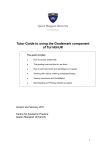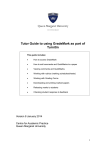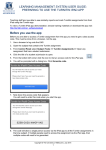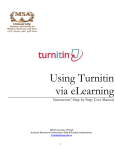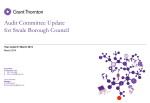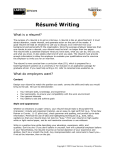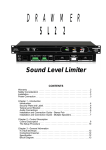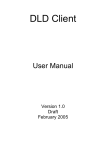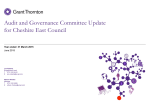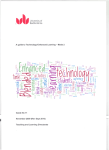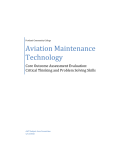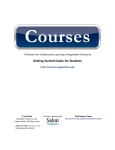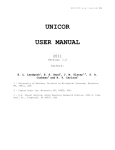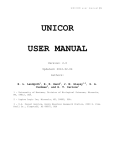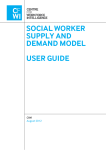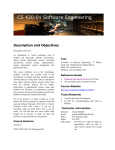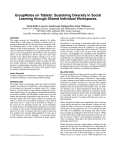Download Tutor Guide to using GradeMark as part of Turnitin
Transcript
Tutor Guide to using GradeMark as part of Turnitin This guide includes: How to access GradeMark How to add comments and QuickMarks to a paper Viewing comments and QuickMarks Working with rubrics (marking schedules/sheets) Downloading and printing marked papers Releasing marks to students Checking student response to feedback Archiving marked papers Version 3 September 2011 Centre for Academic Practice Queen Margaret University 1 Contents 1.0 Introduction ......................................................................................................... 4 1.1 Navigating between papers.............................................................................. 5 1.2 Increasing page size ........................................................................................ 6 1.3 Grading tools ................................................................................................... 6 1.4 Originality report .............................................................................................. 6 2. Adding comments.................................................................................................. 7 2.1 Adding a comment to a specific section of student text (point comments) ...... 8 2.2 Adding a comment to an area of student text (area comments) ....................... 8 2.3 Adding a comment to the side of a paragraph or over some sentences (Inline comments) ............................................................................................................. 8 2.4 Editing and deleting comments ........................................................................ 9 2.5 General Comments ........................................................................................ 10 3. QuickMarks ......................................................................................................... 10 3.1 Adding a QuickMark to student work .............................................................. 10 3.2 Creating your own QuickMark set and adding your comments ........................ 11 3.3 Adding standard QuickMark comments to your QuickMark set ...................... 14 3.4 Importing and exporting QuickMark sets ........................................................ 15 4. Reviewing comments and QuickMarks ............................................................... 15 5. Using rubrics ...................................................................................................... 16 5.1 The standard rubric ....................................................................................... 16 5.1.1 Creating a standard rubric ...................................................................... 17 5.1. 2 Scoring a student’s work using the standard rubric ................................. 20 5.2 The custom rubric .......................................................................................... 21 5.2.1 Creating a custom rubric ......................................................................... 21 5.2.2 Scoring a student’s work using the custom rubric .................................... 23 5.3 The Qualitative rubric ..................................................................................... 24 5.3.1 Creating a qualitative rubric ..................................................................... 24 5.3.2 Adding comments to a student’s work using the qualitative rubric............ 26 5.4 Modifying a rubric .......................................................................................... 27 5.5 Maintaining rubrics ............................................................................................ 27 5.6 Exporting and importing rubrics ..................................................................... 27 6. Maintaining libraries ............................................................................................ 28 7. Statistics, printing and downloading .................................................................... 29 8. Releasing marks to students ............................................................................... 29 8.1 Setting the date when marks are released ..................................................... 29 8.2 Student access to marks and feedback.......................................................... 30 8.3 Ensuring that students do not access marks before the appropriate date ...... 30 8.4 Instructions for students ................................................................................. 30 9. Check student response to feedback .................................................................. 31 10. Archiving marked student work ......................................................................... 31 2 11. Support in using Turnitin/GradeMark ................................................................. 31 12. FAQs ................................................................................................................. 32 Appendix 1 .............................................................................................................. 35 3 1.0 Introduction As a tutor, you can use GradeMark to edit and grade student papers online by: Adding comments within the body of a paper; Evaluating the paper against qualitative or quantitative rubrics. . After marking, you can release the feedback and grade to your students online. This may save you time and improve student access to feedback. GradeMark is available from within the Turnitin “inbox” To use GradeMark, you will need to: Create an assignment in Turnitin within your WebCT module with the appropriate dates, a point value and anonymous marking switched on, if appropriate. Please note with anonymous marking there may be issues with students with extensions – always check these with the School Office Check that the My Grades tool in WebCT is not available to students. With your students: • • • • • Introduce Turnitin to your students and ensure the student guide to Turnitin is available in your WebCT module. The student guide to Turnitin is at: http://www.qmu.ac.uk/ELS/Turnitin.htm Check if any of your students have special needs when using IT in the learning environment and that they have appropriate support. For example, they should have liaised with the Student Disability Advisor in Student Services; Explain to the students that their assignments will be marked and returned to them in your WebCT module and that they do not need to submit to the School Office Submission area in WebCT; Remind the students to use their matriculation number as the name of their file submitted to GradeMark and to add their matriculation number to the header of their work; Inform the students that you can check if they have read their feedback Inform the School Office that you are using GradeMark and to ensure that the School Office administrator has access to your WebCT area; Inform your programme leader and your external examiner that you are using GradeMark. A short video demonstrating GradeMark is available at: https://www.submit.ac.uk/en_gb/support-services Students MUST submit their assignments through Turnitin for you to use GradeMark to mark the assignments. 4 In your WebCT module, you can access GradeMark from within the Turnitin inbox in Teach mode by clicking on the the pencil icon in the Grade column. A new window will open and at the top left-hand corner, there are three buttons: : Check that the GradeMark button is highlighted and through this interface you can add marks and grades to student papers. However please note: you should wait until after the hand-in date to start marking in case a student decides to re-submit; check if there are extensions – you do not want to mark student work that has been submitted formatively to the Turnitin box but is not the final version; if you have set the option to allow students to submit after the due date this allows only students who have not already made a submission to submit their assignment to the dropbox. Resubmissions are not allowed once the due date has passed. Before marking, click on Roster Sync to ensure that you have the complete list of students from your module appearing in the inbox. The Roster Sync will just show a full list of all the students on the module – it has no effect on whether students can submit. By default, all students can see and submit to the submission box regardless of whether Roster Sync has been activated. 1.1 Navigating between papers If you are grading several papers and would like to jump to the next or previous paper without returning to your inbox, you can do so using the navigation links at the top of each paper. At the top right you can go to the next or previous submission for the current assignment: 5 Each time you jump from one paper to another, the paper you are grading is automatically saved. 1.2 Increasing page size When GradeMark opens the student work is often too small to read. In this case move the “slider” at the bottom of the screen to the right to enlarge it: 1.3 Grading tools GradeMark contains the following tools: • • • • Comments (point, area or inline comments); QuickMarks; Rubrics; General comments 1.4 Originality report The percentage for the Originality Report is shown in the top right of the screen: it is referred to as the Similarity Index. It is possible to mark student work and see the Originality Report for this work at the same time. Click on the small button next to the Originality button at the top left-hand corner. A red light will indicate that you have switched on this functionality. When marking the paper, parts of the text will be highlighted in red and this is the paper’s Originality Report. This is a reduced version of the full Originality Report which shows matching text but it does not show details of the matches. The full Originality Report with matches can be viewed by clicking directly on the Originality button. 6 2. Adding comments A comment is equivalent to the notes you, as the tutor, would write in the margins of a student paper. A comment might be: “This paragraph does not relate to the question being asked.” Comments can be any length. They can: Be attached to a certain point in an assignment (point comments); Refer to a number of words/sentences (area comments); Be added to the side of a paragraph or section of student work (inline comments). To use these features, you will need to toggle between bubble and text comments at the top right-hand of the GradeMark screen: Bubble Comment Text Comment 7 2.1 Adding a comment to a specific section of student text (point comments) Click on Bubble Comment. Click on the paper where you would like to add a new comment. Enter text into the text field of the comment popup. Click Save. 2.2 Adding a comment to an area of student text (area comments) Click on Bubble Comment. Highlight the area of text which your comment refers to by dragging the mouse over the area in the student work. Select the Comment button at top right. 2.3 Adding a comment to the side of a paragraph or over some sentences (Inline comments) In some cases, you will want to add comments to the side of a paragraph or over a few sentences. Click on Text Comment at the top right-hand corner of the screen: 8 Click on the area where you would like to add the text comment and type your comment. Once you have created your inline text comment, you can move it to anywhere in the student’s work. Hover the mouse over any corner of the inline text comment and you should see a double-headed arrow. Click and hold on the arrow and you will be able to drag the comment. 2.4 Editing and deleting comments You can edit a comment at any time by hovering over it and clicking on the Edit button. If you would like to move a comment, drag the comment icon to the new location. When necessary, you can delete a comment by hovering over it and clicking on the rubbish bin symbol in the top right of the popup. 9 2.5 General Comments You can write a general comment regarding the student’s paper using the general comments tool. Click the icon at the bottom right of the GradeMark window: The general comment window will open on the right, click on the Edit link at the bottom of the window or click in the Comment window to start or edit the comment. Please note: there is a character limit here of 5000 so this might be useful to summarise achievements. 3. QuickMarks QuickMarks are standard or commonly used editing comments that GradeMark provides including: Composition; Composition marks; Commonly Used; Format; Punctuation; Usage. These are held in the QuickMark library in GradeMark and QuickMark comments are added to the paper by dragging and dropping. Tutors can use these sets, create their own sets or use QuickMarks derived from a combination of sets. To select a QuickMark set, click on the QuickMark link at the top-right 3.1 Adding a QuickMark to student work Select the QuickMark set that you would like to use. Click on the QuickMark comment you are going to use and drag it to the appropriate area of the student’s work. 10 You can add additional comments to the QuickMark comment by clicking on Comment and personalise the feedback. 3.2 Creating your own QuickMark set and adding your comments In GradeMark you can create your own QuickMark set which you can use in different modules which is based on your feedback comments. Click on QuickMark Manager at the top-right of the screen: 11 The following screen appears. Click on the plus sign: Type a suitable name into the text window and click Save. 12 Your set will appear in the list of sets on the left of the window. To add QuickMarks to your set, make sure your new set is highlighted and click on the “+” sign in the middle column. Enter the following information for your QuickMark set: Title Description Click Save to save the new QuickMark (here called “English”) in your set. 13 To edit the new QuickMark, select it and click Edit. To add an additional QuickMark to your own set, start by clicking on the “+” sign in the middle column and continue as above. To delete a comment, click on Actions and Other and Remove from this set: 3.3 Adding standard QuickMark comments to your QuickMark set It is possible to add a standard QuickMark comment to your personal QuickMark set. Click on QuickMark Manager Click on the QuickMark set where the comment is stored Click on the QuickMark comment you wish to copy into your QuickMark set Click on Actions/ Add set and then select your personalised QuickMark set. In the example below the standard QuickMark comment Missing is being copied. 14 3.4 Importing and exporting QuickMark sets QuickMark sets can be shared with other tutors. Click on the QuickMark Manager Click on the set that you want to share Click on the import/export button towards the top-right Click Export Set and save the file in your documents. Share the file with your colleagues. They will need to import the file through the QuickMark Manager. Please note: you cannot open the QuickMark set in any other application or QuickMark sets that have been created by another user. 4. Reviewing comments and QuickMarks To review all comments and QuickMarks inserted in a student paper, click the icon at the bottom right of the GradeMark screen: View all QuickMarks and comments for this paper: 15 In this example, the student work has four comments and one QuickMark: You can navigate directly to a specific comment or QuickMark in the paper by hovering the mouse over an entry in the list and then clicking on the show on paper. 5. Using rubrics Rubrics can be set up in GradeMark and then be used to score student work based on defined criteria and scales. You may already have an assessment marking sheet upon which you can base your rubric (see Appendix 1). There are three types of rubric: Standard Custom Qualitative You can weight selected criterion and mark each in bands. For each criterion, you can mark in bands. Here you create criterion which have no grades attached. 5.1 The standard rubric This lets the tutor assign a pre-defined mark for each criterion and to weight the criteria using percentages. The total mark equals the sum of all weighted marks. Please note: it is not possible to add specific individual marks for each criteria. You can only allocate a mark for each criterion from those that have been defined in the rubric. For example, if one of the criteria was synthesis then you could allocate 100 or 90 but not 95. It is recommended that the final score generated by the standard rubric is checked by the tutor and in some cases adjusted. 16 BEFORE USING THIS RUBRIC, CHECK THE MARKS (POINT VALUE) THAT YOU HAVE ALLOCATED TO THIS ASSESSMENT WHEN YOU SET UP THE TURNITIN LINK. If you cannot remember the marks that you have allocated to the assignment: Go the WebCT area and click on TEACH Click on the Turnitin link Select the edit assignment tab Check the point value for the assignment. 5.1.1 Creating a standard rubric Click on the View/Edit Rubric button at the bottom right of the GradeMark screen: .Click on the Rubrics Manager link at the top right of the page Click on the top left-side and Create New Rubric.. Add a name at the top of the screen – Rubric 1 in this example . 17 • Click on the % icon at the bottom of the screen. • First you need to add criterion: • • Change the name of each criterion. Please note that there are limits on the length of names of fields. To add further information about the criterion, click in the space beneath the criterion. If there are insufficient rows, click on the ‘+’ and add further rows. • Provide a percentage for each criterion. • Next, add the scale: o Click on each column and add the grade and the mark associated for each grade. o Click on the ‘+’ if you need to add more columns. 18 Please note: it is not possible to assign a range of marks for each grade. In this example, a student receiving grade A would receive 100%, grade B 79.9%. It is also possible to add specific information about the mark allocated for each criterion as in the example below. • • Click on Save to finish. To use the new rubric with student work, click on the chain symbol and then on Close. 19 5.1. 2 Scoring a student’s work using the standard rubric When you have marked a student’s work, you can select a grade for each criterion. As you hover over each criterion, at the bottom of the rubric you will see further information about the criterion. As you select a grade for each criterion, the grade will be highlighted in blue. After your have graded each criterion, GradeMark will provide you with a final mark for each student. Click Apply rubric percentage to grade and this will show the overall percentage in the Grade field. In the example, below, the student’s final mark is 73%. It is possible to change criterion until the mark is released to the student. The grade itself can be edited by clicking in the Grade field and overwriting the mark applied from the rubric. PLEASE NOTE IT IS POSSIBLE TO OVERWRITE THE MARK CREATED BY GRADEMARK BY MANUALLY ENTERING A DIFFERENT GRADE IN THE GRADE FIELD. 20 5.2 The custom rubric This rubric allows you as the tutor to allocate specific marks to selected criterion. BEFORE USING THIS RUBRIC, CHECK THE MARKS THAT YOU HAVE ALLOCATED TO THIS ASSESSMENT WHEN YOU SET UP THE TURNITIN LINK. If you cannot remember the marks that you have allocated to the assignment: go the WebCT area and click on TEACH click on the Turnitin link select the edit assignment tab check the point value for the assignment. 5.2.1 Creating a custom rubric Click on the View / Edit Rubric button at the bottom right of the GradeMark screen: Click on the Rubrics Manager link at the top right of the page Create your new rubric. Add a name at the top of the screen – Rubric 1 in this example . 21 • Click on the custom rubric icon at the bottom of the screen. • First add criterion: • • • Change the name of each criterion. Please note that there are limits on the length of names of fields. To add further information about the criterion, click in the space beneath the criterion. If there are insufficient rows, click on the ‘+’ and add further rows. Next add the scale: o Click on each column and add the specific mark associated for each criterion. o Click on the ‘+’ if you need to add more columns. 22 Please note: it is not possible to assign a range of marks for each criterion. In this example, a student would receive 20 marks for the criterion Knowledge. • Click Save to finish • To use the new rubric with student work, click on the chain symbol and then on Close. 5.2.2 Scoring a student’s work using the custom rubric When you have finished providing comments on a student’s work, you can select a specific mark for each criterion in the rubric. As you hover over each mark for each criterion, at the bottom of the rubric you will see further information about the criterion. 23 As you select a mark for each criterion, the mark will be highlighted in blue. After your have marked each criterion, GradeMark will provide you with a final mark for each student. Click Apply rubric percentage to grade and this will show the overall marks against the total possible marks. In this case, 52 out of 100. PLEASE NOTE IT IS POSSIBLE TO OVERWRITE THE MARK CREATED BY GRADEMARK BY MANUALLY ENTERING A DIFFERENT GRADE IN THE GRADE FIELD. 5.3 The Qualitative rubric This rubric allows you as the tutor to provide comments on selected criterion. GradeMark does not automatically create a grade. BEFORE USING THIS RUBRIC, CHECK THE MARKS THAT YOU HAVE ALLOCATED TO THIS ASSESSMENT WHEN YOU SET UP THE TURNITIN LINK. If you cannot remember the marks that you have allocated to the assignment: go the WebCT area and click on TEACH click on the Turnitin link select the edit assignment tab check the point value for the assignment. 5.3.1 Creating a qualitative rubric Click on the View / Edit Rubric button at the bottom right of the GradeMark screen: 24 . Click on the Rubrics Manager link at the top right of the page Create a new rubric. Add a name at the top of the screen – Rubric 1 in this example • Click on the qualitative rubric icon at the bottom of the screen • Adding criterion: . • • • Change the name of each criterion. Please note that there are limits on the length of names of fields. To add further information about the criterion, click in the space beneath the criterion. If there are insufficient rows, click on the ‘+’ and add further rows. 25 Next add the scale: o Click on each column and add a grade associated for each criterion. o Click on the ‘+’ if you need to add more columns. • Click Save to finish • To use the new rubric with student work, click on the chain symbol and then on Close. • Please note: it is not possible to edit rubrics created by other tutors. 5.3.2 Adding comments to a student’s work using the qualitative rubric When you have finished providing comments on a student’s work, you can select a specific grade for each criterion in the rubric. As you hover over each grade for each criterion, at the bottom of the rubric you will see further information about the criterion. For this rubric, you can add a numeric grade in the grade field at the top of the paper: 26 5.4 Modifying a rubric To modify a rubric: Click on the Rubric Manager link and select the rubric that you want to edit Click on the text you would like to modify and make the changes Click Save and then Close. WARNING: Do not make changes to a rubric which is already being used for a marking. To make changes, you will have to de-attach a rubric from an assessment, make changes and then re-attach the rubric. However, any papers that were marked with the first rubric will be lost. 5.5 Maintaining rubrics When in any rubric, by clicking here a tutor can: Create another rubric Duplicate an existing rubric Rename an existing rubric Delete an existing rubric (if they have not be used to mark student work) Select a rubric other than the one displayed. 5.6 Exporting and importing rubrics To share rubrics. Click on the Rubric Manager link and select the rubric that you want to export from the drop-down menu Click on the import/export link and Save the rubric file to your documents. Send the file to another tutor who can then import the file into their GradeMark. 27 6. Maintaining libraries Both the QuickMarks and Rubrics can be maintained by clicking on the libraries tab at the top of the Turnitin inbox: The appropriate library can be accessed by clicking on its name; here we are in the QuickMark Manager: 28 7. Statistics, printing and downloading To see some summary statistics for the student paper, click on the information icon: To print a marked up paper, click on the print icon: To download a marked up paper to a local file space, click on the basket icon: 8. Releasing marks to students 8.1 Setting the date when marks are released Your marked papers should be released to students on the post date and time set in your assignment details created when setting up the Turnitin assignment in WebCT. Always send marks and grades to the School Office in the appropriate Excel sheet before releasing marks in GradeMark. Please note: if you are using anonymous marking once the marks are released the anonymous marking will be switched off and you, as the tutor, will be able to see the grades and names of the students. 29 8.2 Student access to marks and feedback After release, students can view their marked paper via the Turnitin link in the WebCT module ie where they originally submitted. All your comments, QuickMarks etc will be visible as will the assigned mark. 8.3 Ensuring that students do not access marks before the appropriate date It is important to stop WebCT from releasing marks through the WebCT My Grades tool to students. As soon as you add a mark in GradeMark, it will be displayed in the GradeBook tool in WebCT which can be accessed by students through the My Grades tool in your WebCT module. By default, WebCT will release grades through My Grades To prevent this ensure that students do not have the tool My Grades. If they do, then it will need to be removed. In BUILD, click on Mange course/ tools and remove the My Grades tool for students. 8.4 Instructions for students You should consider giving your students specific instructions regarding access to their marked submissions.. The following text is given as an example: “I have marked your submission for the above and, subject to the External Examiner verifying this, I am pleased to confirm that you have (passed/failed) the module. To view comments on your coursework you need to access your WebCT module. Click on the link to Turnitin where you submitted your assignment. Click on Show details in the Actions column which will show you the name of your assignment. Click in the Grademark column which is to the right of your Turnitin Report. This will show you your grade and you should be able to click on the following boxes at the bottom right hand corner. 1. View general comments for the entire paper. 2. View all QuickMarks and comments for the paper. 3. View rubric scorecard for the paper. Only use this if you are using a rubric: The latter scorecard will show you the standard you have achieved on various criteria, what this means, and how the marks attributed to the grade have been translated into an overall mark. Please contact me if you are unable to access these marks.” 30 9. Check student response to feedback In GradeMark you can check to see if students have accessed and viewedtheir marked work for more than 1 minute. After releasing the marked work, the column Response indicates if students have viewed their GradeMarked paper. In the example below, only one of the students has viewed their feedback. 10. Archiving marked student work When a WebCT module containing scripts marked in GradeMark is archived and copied forward at the end of an academic session, all marked scripts will become unavailable although the marks will continue to be available in the WebCT Gradebook. Your School Office administrator will download copies of the marked work to be stored in the School Office. When emailing marks to your administrators, remind them to download the marked assignments from GradeMark. 11. Support in using Turnitin/GradeMark The Centre for Academic Practice (CAP) website also has a range of support material including WebCT guides: http://www.qmu.ac.uk/cap/TELwebCT.htm For student support about plagiarism: http://www.qmu.ac.uk/ELS/Plagiarism.htm Email Support 31 If you have queries regarding GradeMark, please contact [email protected]. 12. FAQs Can I let another member of the programme team/external examiner/school administrator see the graded paper before releasing it to the student? Yes – ask CAP to make the other party a Teaching Assistant on the WebCT module in question. This will allow the third party to see the papers in the Turnitin inbox and, if necessary, they can make changes, edit comments and change the grade. You may want to extend the post date of the assignment to delay release to students so there is sufficient time for reviewing. Please note: it is possible for moderators/external examiners to change marks and comments and there is no indication that a change has been made and who made the change. What happens when my WebCT module is archived? WebCT modules are always archived at the end of the academic year. When this is done, the Turnitin link will no longer be available and so the marked up papers cannot be viewed. It is important to create a PDF archive copy of the marked scripts before the archiving. The School Office remains responsible for ensuring that student work is retained for the specific period required. If there are special issues eg a plagiarism case, then CAP should be informed so that archiving of that particular module can be delayed or the archive PDF copy can be used. If a paper has been graded and there is no copy, iParadigms [email protected] may be contacted as they keep papers indefinitely. What happens if I have a visually impaired student? You should contact the relevant disability co-ordinator to ascertain the particular needs of the student. It may be necessary to provide the output of GradeMark in paper form. When I have finished marking the assessment, does the student see it automatically? No – the student cannot see the assessment until the “post- date” as specified when setting up the Turnitin assignment. However, remember to remove student access to the My Grades tool in WebCT since students can use this to access grades before they have been officially released. Can I use audio feedback with GradeMark? At the moment no, but this functionality should be available in the near future. 32 How do I use GradeMark for extensions, deferrals and re-sits? You should set your post date several weeks after your due date. This will allow a short extension to submit. For deferrals and re-sits, you will need to create a new Turnitin submission. In order to prevent the Originality Report from showing high levels of plagiarism because the student may have submitted to the original Turnitin box or elsewhere, the new box for resubmissions needs to be set slightly differently. In the options when creating the submission box there is the choice regarding submission to a repository: By default the setting will show Standard Paper Repository. For resubmissions this setting should be changed to No Repository. The paper will still be matched against the Turnitin database but it will not be matched against any submissions from other assignments submitted to that WebCT area; therefore avoiding a high originality report where a paper has matched against the student’s previous submission. It is also possible to remove matches in an Original Report in the document viewer mode of Turnitin, if necessary. What happens if a student has submitted to Turnitin but then asks for an extension? If you are not using anonymous marking, you will be able to see the names of the students and do not need to mark the students’ work. If you are using anonymous marking, you will not know which work belongs to which student but students should have used their matriculation numbers as the name of the submission file. In this way you will be able to ignore student work that should not be worked.. Why is it possible to put a mark of more than 100% in the Grade box? This functionality is an intentional feature which is used in the United States. Although a mark of more than 100% can be input to the grade field, it would not be normal to do so at QMU. Can I use my iPad with GradeMark? The iPad does work with GradeMark but not all functionality is available such as QuickMark sets. 33 How do I print out the rubric? Once you have added a rubric into GradeMark, the best way to print it is to submit a paper to the assignment dropbox (perhaps with the assessment guidelines). Check that the rubric has been attached to the submission, do not mark the paper but just click on the print icon to print out a marked assessment. This will provide you with a PDF document which contains the assessment guidelines and the rubric. This can be printed or the PDF can be uploaded to WebCT. 34 Appendix 1 a) QMU Marking Sheet Student ID: Marker: Date: Mark Marking criteria Grade A Report All aspects of model are covered Report is incomplete Manager appreciation level is maintained throughout Language is inappropriate Model handles all requirements with suitable functions Incorrect results obtained 1. Report is comprehensive 2. Description is in appropriate language Mark: /20 Spreadsheet Model A B C D E F G Pass Fail Grade G 3. All functions are operational 4. User interface is suitable Interface is readily accessible and easy to understand Interface not present 5. Setup interface is suitable Interface is readily accessible and easy to understand Interface not present Mark: /40 6. Structure is clear Contents page present and correct Essential sections missing 7. Content is appropriate for its purpose All aspects of the model are documented Some aspects not present 8. Language used is suitable for non-technical personnel Mark: /20 All sections are written in clear terms with abbreviations kept to a minimum Language inappropriate Contents page present and correct Essential sections missing 10. Content is appropriate for its purpose All aspects of setting up the model are documented 11. Language used is suitable for non-technical personnel Mark: /20 All sections are written in clear terms with abbreviations kept to a minimum Model cannot be set up via instructions Language inappropriate User Manual Setup Manual 9. Structure is clear Comment 35 % Comments b) Rubric in GradeMark Grading Scale A B C D E F G 100% 80% 60% 50% 40% 30% 0% Report1 10pts Report is comprehensive Report2 10 pts Description is in appropriate language Model1 20pts All model functions are operational Model2 10pts User interface is suitable Model3 10pts Setup interface is suitable UManual1 5pt User manual structure is clear UManual2 10pts User manual content is appropriate for its purpose UManual3 5pts User manual language is appropriate for its purpose SManual1 5pts Setup manual structure is clear SManual2 10pts Setup manual content is appropriate for its purpose SManual3 5pts Setup manual language used is suitable for nontechnical personnel 36




































